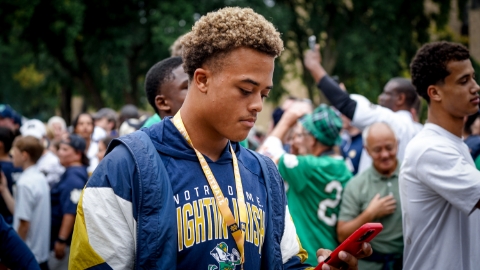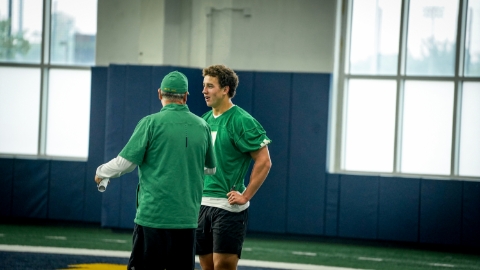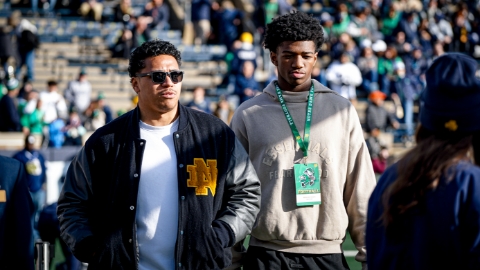
No position is under the microscope more for Notre Dame this offseason than wide receiver. Whether it’s the health of Kevin Austin, players entering the transfer portal, or the needs they have in recruiting, all eyes are on a position that has to be better for the offense to take the next step over the next few years.
Notre Dame wants more big plays from their receivers. They have to in order to keep pace with the top programs in the country. From a piece I wrote back in January:
The Irish had a play of 20 yards or more every 14 plays. That’s down from every 11 in 2019 and a far cry from the rate of top teams they are competing with.
Ohio State averaged an explosive play every 10.9 plays in 2019 and every 9.4 plays this season. Alabama was at 8.8 and 10.4 the last two years. Even with significant injuries at the wide receiver position, Clemson was at 11.1 in 2020. They were at 10.8 per in ‘19. The 2019 national champion, LSU, averaged one every 9.6 plays.
The simplest answer when it comes to producing more types of those plays is to do it through the air. It starts with the quarterback and ends with the players they are putting out there at wide receiver.
The 2021 receiver room for Notre Dame looks different than it has in recent years. Gone are the big bodies that were a key component on the offense in the last five years. The Irish are smaller. Much smaller. Three of their top-five projected receivers under 6’0” tall.
Avery Davis, Lawrence Keys, and Braden Lenzy have skills that can help this year’s offense be more explosive. They can be valuable pieces to help Notre Dame be more productive in the passing game. However, it would be inaccurate to predict that they or others similar to them can help the Irish get to the same level of explosive rate that Ohio State, Alabama, and Clemson have had in recent years.
That’s because the players who most frequently produce those kinds of plays are bigger.
Out of the top-20 Power 5 receivers in receptions of 20-yards or more, 82.6% of them have been over 6’0” over the last four college football seasons. Most of those players are 6’3” or taller. If we break it down into yards per route run, a metric that measures efficiency and explosiveness, it’s 73.6% that are above 6’0”. Alabama’s Jaylen Waddle, a top-20 Power 5 receiver in YPRR in each of the last three seasons, is more of a unicorn. When it comes to big plays in the passing game, bigger is generally better.
There has been debate recently about Notre Dame recruiting too many of the same body type at receiver during the 2022 cycle. The response to anyone questioning that should be that programs can never have enough of those big bodies out wide. The evidence shows that players like Chase Claypool and Miles Boykin are the ones who produce the results the Irish are looking for in the passing game.
They could very well end up with a class that consists of Nicholas Anderson (6’5”), Tobias Merriweather (6’4”), Amorion Walker (6’3”), and CJ Williams (6’2”). That might have been seen as an undesirable scenario previously when the focus might have been on finding the next Will Fuller.
But Anderson, Merriweather, and Walker can all stretch the field. Walker ran a reported 4.41 at Alabama’s camp. Williams may not jump off the screen as a burner, but he fits the new breed of bigger players who can succeed in the slot and his ability to win contested catches makes him a tough matchup against typically smaller slot corners. (I wrote about playing bigger receivers in the slot back in March.)
There are always exceptions with smaller players who have dynamic speed. Boston College’s Zay Flowers and Ole Miss’ Elijah Moore, both under 6’0”, were two of the best big play receivers during the 2020 season. Small guys like Louisville’s TuTu Atwell, Texas’ Devin Duvernay, and Penn State’s KJ Hamler were a few of the most explosive receivers in college football in 2019.
The numbers don’t lie, though. Getting a variety of body types isn’t as important as finding bigger receivers who can win down the field. Notre Dame has made those bigger players a priority in the 2022 class and it’s the correct approach if they want to produce more receptions of 20-yards or more.



